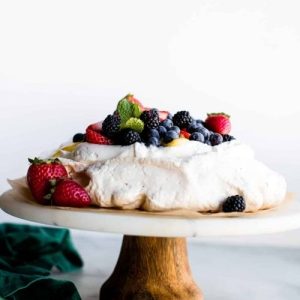
Easy Homemade Pavlova
Crisp on the edges, soft in the center, and endlessly customizable with fruits or creams, this Pavlova is a naturally gluten-free dessert perfect for everyday indulgence or special occasions.
Equipment
- 1 — Electric mixer (handheld or stand)
- 1 Large Baking Sheet
- 1 Silicone Baking Mat or Parchment Paper
- 1 rubber spatula
- 1 Whisk attachment (if using a stand mixer)
- 1 Marble cake stand or serving platter
Ingredients
Pavlova Base:
- 4 large egg whites room temperature
- 1 cup 200 g superfine sugar
- 1 teaspoon pure vanilla extract
- ½ teaspoon cream of tartar
- 1 teaspoon cornstarch
Toppings (Optional):
- Homemade whipped cream
- Fresh fruits strawberries, kiwi, berries, etc.
- Strawberry sauce or fruit compote
- Lemon curd
Instructions
- Preheat and Prepare the Oven: Begin by preheating your oven to 350°F (177°C). While waiting, line a large baking sheet with parchment paper or a silicone baking mat. Ensure the surface is smooth and free of wrinkles, as any unevenness can affect the Pavlova’s shape. Note: Once the Pavlova is in the oven, you will reduce the temperature, so don’t worry about it being too hot at this stage.
- Whip the Egg Whites to Soft Peaks: Place 4 room-temperature egg whites into a large, clean mixing bowl. Using a handheld mixer or a stand mixer with a whisk attachment, beat the egg whites on medium-high speed. Continue until soft peaks form—this should take about 5 minutes. To test, lift the whisk: the peaks should bend slightly but not collapse. This step is essential for achieving the Pavlova’s airy texture.
- Gradually Add Sugar for Glossy Peaks: Once soft peaks have formed, gradually add 1 cup (200 g) of superfine sugar, in two separate additions. Beat for 30 seconds between each addition to allow the sugar to fully dissolve. After all the sugar has been incorporated, increase the mixer speed to high and beat for an additional 2 minutes. The mixture should become glossy and hold stiff peaks. The peaks should remain upright when you lift the whisk, ensuring the Pavlova will rise beautifully.
- Incorporate Flavor and Stabilizers: Add 1 teaspoon of pure vanilla extract to the egg white mixture and beat for another minute. Next, gently fold in 1/2 teaspoon cream of tartar and 1 teaspoon cornstarch using a rubber spatula. These ingredients stabilize the egg whites and give the Pavlova its iconic marshmallow-soft center. Fold carefully to avoid deflating the mixture while ensuring all ingredients are evenly combined.
- Shape the Pavlova: Transfer the mixture to the prepared baking sheet. Using a spatula or the back of a large spoon, spread it into an 8–9 inch circle. Make the edges slightly higher than the center to create a shallow well for toppings later. You can also create decorative peaks along the edges for a professional look. For mini Pavlovas, divide the mixture into 6 portions, leaving a small dip in each for toppings.
- Bake the Pavlova Slowly: Place the Pavlova into the preheated oven. Immediately reduce the temperature to 200°F (93°C). Bake the Pavlova for approximately 90 minutes, or until the exterior is dry and crisp. Rotate the baking sheet halfway through to ensure even baking. Avoid opening the oven frequently, as sudden cool air can cause cracking. The slow, low-temperature baking is crucial for a crisp shell and soft, marshmallow-like interior.
- Cool the Pavlova Gently: Once baked, turn off the oven and leave the Pavlova inside to cool completely. This gradual cooling prevents cracking and keeps the texture perfect. Do not remove it immediately; patience at this stage ensures the Pavlova maintains its delicate structure.
- Prepare Toppings: While the Pavlova cools, prepare your desired toppings. Whip cream until soft peaks form, slice fresh fruits, or make lemon curd. This step is flexible—use seasonal fruits, berries, or a combination for a vibrant presentation. The Pavlova’s center is a perfect canvas for a mix of flavors and textures.
- Assemble the Dessert: Once the Pavlova has cooled, transfer it to a serving platter or cake stand carefully. Spoon whipped cream into the center and arrange fruits or other toppings as desired. For extra elegance, drizzle with lemon curd or fruit sauce. The Pavlova is best served immediately after garnishing, as the cream and fruits can soften the crisp edges over time.
- Serve and Enjoy: Slice the Pavlova with a sharp knife or spatula and serve each portion with a bit of cream and fruit. Enjoy the combination of crisp edges, marshmallow-soft center, and fresh, juicy toppings. Leftovers can be stored at room temperature for up to 2 days, though Pavlova is at its best when freshly made.
Notes
- Room Temperature Egg Whites: Using egg whites at room temperature whips faster and achieves greater volume, creating a lighter, airier Pavlova.
- Superfine Sugar: This dissolves quickly and prevents a grainy texture; pulse granulated sugar in a food processor if needed.
- Acid Option: Cream of tartar stabilizes the meringue, but vinegar or lemon juice can also be used.
- Shape Tips: Taller edges with a shallow center hold toppings better and create a classic Pavlova look.
- Mini Pavlovas: Perfect for individual servings; bake smaller portions at 200°F (93°C) for 35–40 minutes.
- Timing for Best Texture: Pavlova is best served the same day it’s garnished; store un-topped bases for up to 2 days.